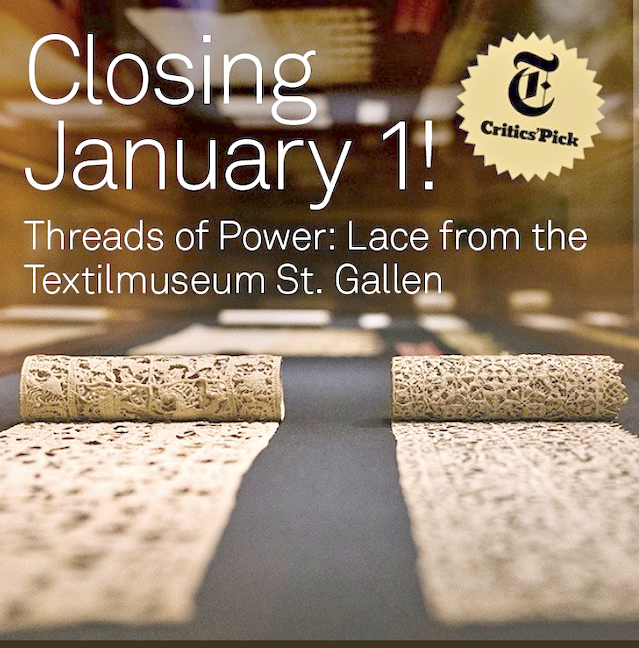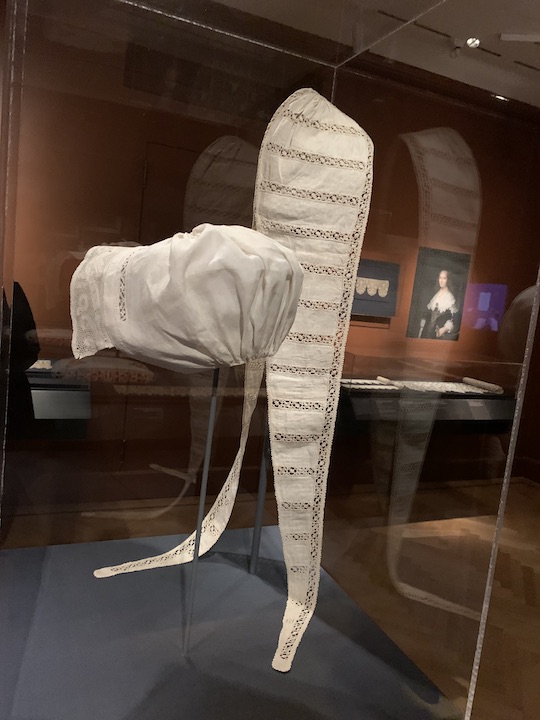~’THREADS of POWER: LACE from the TEXTILMUSEUM ST. GALLEN’ / BARD GRADUATE CENTER GALLERY, UPTOWN NYC / LAST FEW DAYS !!
THE HISTORY of . . . LACE & LACE-MAKING !!
LAST FEW DAYS: WED DEC 28 / THURS DEC 29 / FRI DEC 30 / SAT DEC 31 / SUN JAN 1
PURCHASE – YOUR – TICKETS, NOW !!!!
GO TO:
‘THREADS of POWER: LACE from the TEXTILMUSEUM ST. GALLEN’
BARD GRADUATE CENTER GALLERY
18 WEST 86th ST. NY NY 10024
CURATED BY: EMMA CORMACK, associate curator, Bard Graduate Center; ILONA KOS, curator, Textilmuseum St. Gallen; and MICHELE MAJER, professor emerita, Bard Graduate Center
WONDERFUL, INTIMATE PRESENTATION / RIVETING EXAMPLES / CONCISE, INFORMATIVE TEXT . . !!
& A GORGEOUS, MOST GORGEOUS . . HARDCOVER CATALOG, AVAILABLE TOO.
HERE’S A LITTLE SAMPLING – FROM MY MOST LOVELY VISIT – THIS PAST SATURDAY:
foreground: Bonnet with reticella needle-lace & bobbin-lace inserts of geometric, vegetal, & bird motifs /
Netherlands or western Europe / 1600-50 / Linen
Textilmuseum St. Gallen, Acquired from the Estate of John Jacoby, 1954, 23402
behind: Bonnet with reticella needle-lace inserts / Italy / Second half of the 16th century / Linen
Textilmuseum St. Galler, Acquired from the Estate of John Jacoby, 1954, 00813
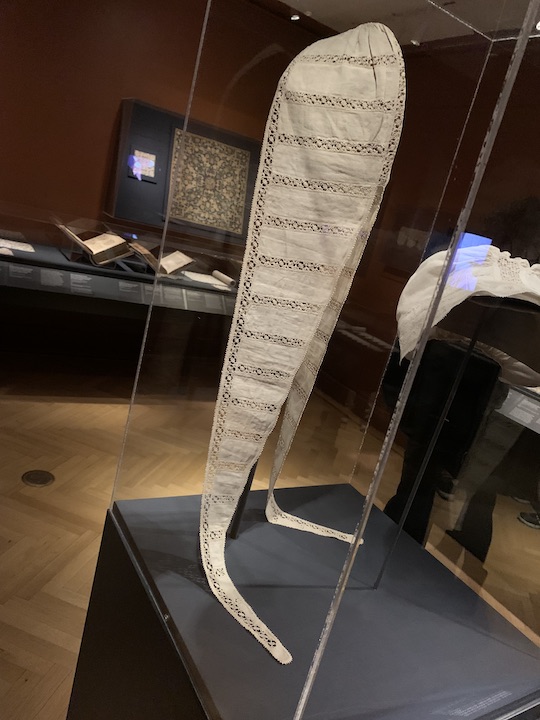
the (short) bonnet in the front was interesting, because it could ‘extend’, or be pulled way forward, with all those folds pf extra fabric / to shade your face; but the bonnet with the long ‘ties’ – to the back of the photo, really, really fascinated me / it reminded me of a modern day . . hoodie !!
you could just imagine pulling your head way deep into its ‘cap’, and then ‘twisting’ those long ties up around your face & neck, essentially a hoodie / or . . . letting them fly free, as you ran, if you were feeling less furtive, and more . . playful !!
reticella lace: “is a needle lace dating from the 15th century & remaining popular into the first quarter of the 17th century. originally a form of ‘cutwork’ (embroidery) in which threads were pulled from linen fabric to make a ‘grid’ / on which the pattern was stitched, or embroidered – primarily using the buttonhole stitch. (Wikipedia)
note: if you collect Americana, esp early handkerchiefs !! you will be familiar with this . . . early “percursor to true lace’.(the exhibit catalog.)
you can even sometimes find this ‘cutwork’, though it’s rare . . embellishing old (fancy) quilt borders.
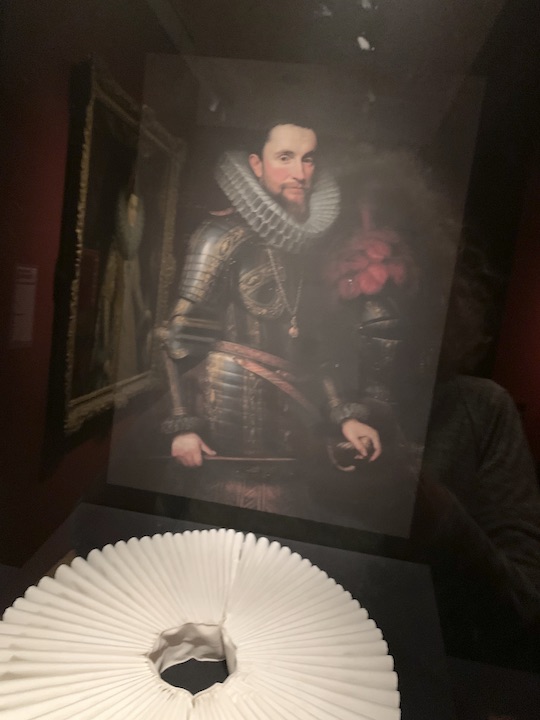
throughout the exhibit . . are colorful examples of the actual lace-work in question – in ‘play’, through paintings, facsimiles, & then archival photographs, as when we approach the modern era.
I’ve always been fascinated by these huge ‘ruffle’ collars, esp through Shakespearean era portraits & Elizabeth I.
“In the mid-sixteenth century, men’s shirts & women’s shifts acquired small standing frilled collars that often incorporated cutwork & freely formed, detached lace points. As these techniques became more elaborate, collars grew larger & more heavily decorated until, by the end of the century, they were made as separate accessories…
At the turn of the seventeenth century, deeply fluted millstone collars trimmed with expensive cutwork or lace were the height of fashion, requiring laborious laundering, setting, and starching.”
~exhibition text
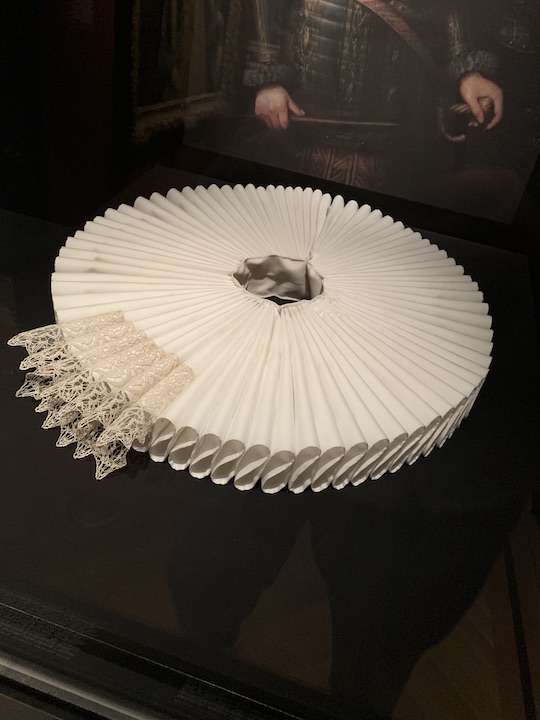
so this actual artifact – was a real eye-opener !!!!!
talk about . . . infra-structure !!
Bobbin-lace border with rosettes, festoons, & delicate fillings mounted as a millstone collar /
Flanders, Southern Netherlands / second quarter of the 17th century / Linen
Textilmuseum St. Gallen, 00604
note: “the ruff collar, worn by men, women & children, evolved from the small fabric ruffle at the neck of the shirt or chemise. Ruffs served as changeable pieces of cloth that could themselves be laundered separately while keeping the wearer’s doublet or gown from becoming soiled at the neckline.” ~WIKI
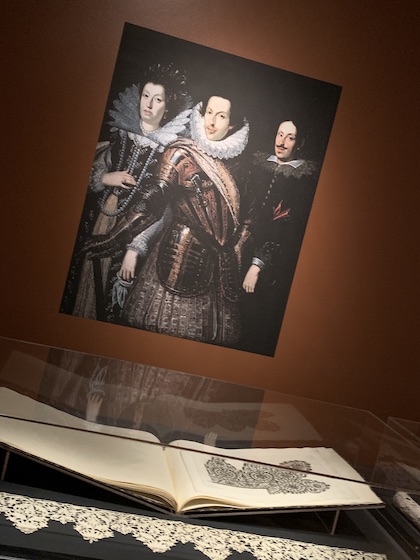
bottom display case:
“Bartolmeo Danieli published four lace pattern books between 1610 and 1641.
Designing suitable patterns for needle & bobbin laces required specialized knowledge, and the fact that Daniele was himself a lacemaker comes through clearly in his intricate designs for scalloped lace borders featuring floral & foliate motifs, flowerpots, and birds. Danieli’s volumes cotain plates made with an etching needle, a departure from the typical woodblock prints of other pattern books . . . ”
~exhibition note
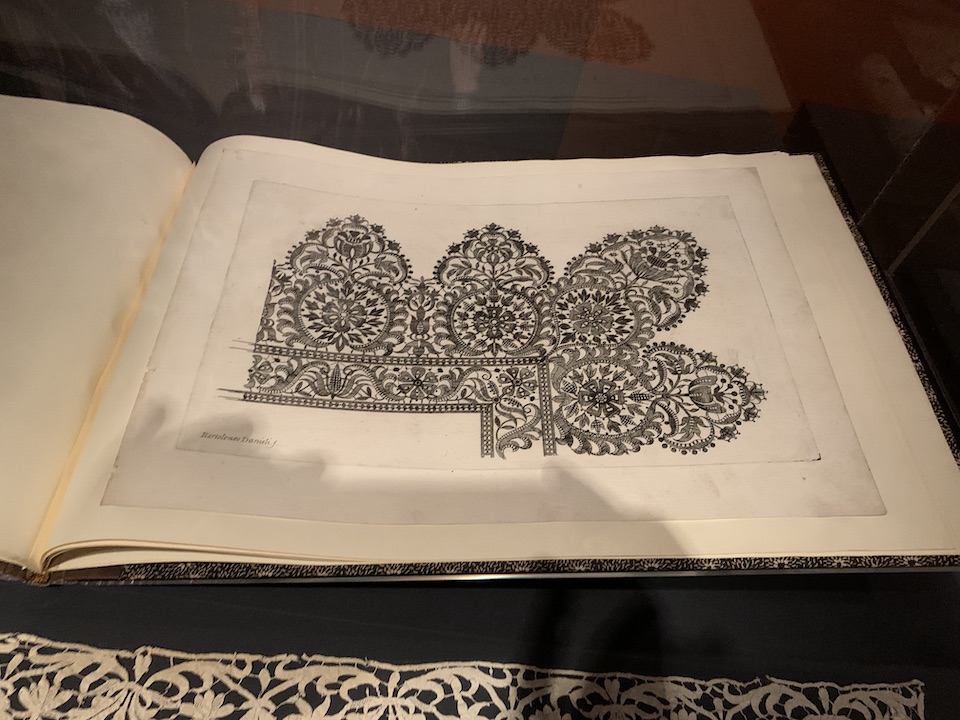
detail: actual, original, archival . . . BARTOLMEO DANIELI lace pattern book.
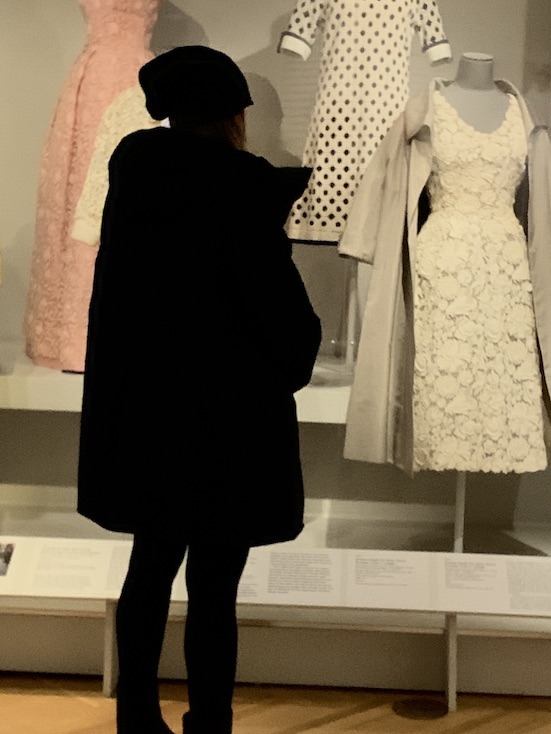
the exhibition follows a chronological order /
so . .
on a top floor, of the compact NYC townhouse, (there is an elevator) which serves as the Bard Graduate Center Gallery, we find modern & contemporary lace / the history, how it is made, and variations . . of what it is – made into.
Lace, and ‘see-through’ couture . . a spin-off of new-found ‘craft’ respect . . is actually having a major major moment – in fashion right now.
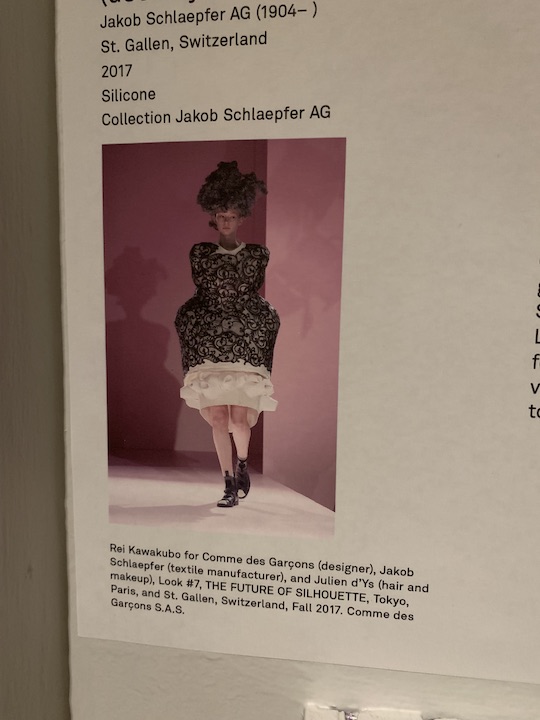
the history of the manufacturing techniques, that allowed for mass production / are just as fascinating to watch develop, as was the earlier . . hand-made history !!
“Sample of hypertube guipure (used by Comme des Garcons)
Jakob Schlaepfer AG (1904-) / St. Gallen, Switzerland, 2017 / Silicone
Collection Jakob Schlaepfer AG”
“REI KAWAKUBO for Comme des Garcons (designer), Jakob Schlaepfer (textile manufacturer),
and Julien d’Ys (hair and makeup), Look#7, THE FUTURE OF SILHOUETTE, Tokyo, Paris, and
St. Gallen, Switzerland, Fall 2017.
Comme des Garcons S.A.S.”
“an example of what Jakob Schlaepfer refers to as hypertube guipure. It is manufactured through a computerized process that applies silicone pigments to fabric as one might apply a thread. This type of 3D printing can also produce hypertube without a base fabric . . which creates a closer approximation of traditional lace.”
~exhibition notes
2017 ?
‘THE FUTURE OF SILHOUETTE’ .. ?
well, they sure . . nailed that !!!!!!
PHOTOS: NANCY SMITH / DEC 24, 2022

